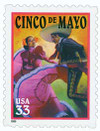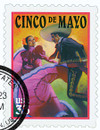
# 3309 - 1999 33c Cinco de Mayo
US #3309
1999 Cinco De Mayo – Holiday Celebrations Series
- To celebrate Cinco de Mayo and recognize Mexican-American heritage in the United States
- Includes the same design as the 1998 Cinco de Mayo stamp, but with a 1¢ increase in denomination
Stamp Category: Commemorative
Series: Holiday Celebrations
Value: 33¢ First Class Mail Rate
First Day of Issue: April 27, 1999
First Day City: San Antonio, Texas
Quantity Issued: 105,000,000
Printed by: Banknote Corporation of America
Printing Method: Offset, Microprint
Format: Panes of 20 (Vertical 5 across, 4 down)
Perforations: 11.5 x 11.4 (Die-cut simulated perforations) (Rotary die-cutter)
Tagging: Phosphored paper
Why the stamp was issued: To update the 1998 Cinco de Mayo stamp with the new First Class Mail Rate (33¢).
About the stamp design: Uses the same acrylic painting by Robert Rodriguez that was on the 1998 Cinco de Mayo stamp. It shows a male and female dancer wearing traditional costumes.
Special design details: Since the 1999 stamp was offset printed, the tiny details are more crisp and defined than the 1998 stamp design.
First Day City: There was no First Day of Issue Ceremony for this stamp in San Antonio, Texas, as there had been one the previous year for the 1998 Cinco de Mayo stamp.
About the Holiday Celebrations Series: The USPS introduced the Holiday Celebration series in 1996 with a stamp honoring the Jewish festival, Hanukkah. The series commemorated a different cultural or religious holiday each year.
History the stamp represents: After the Mexican-American war of 1846-48 and the Reform War of 1858-61, Mexico’s Treasury was nearly bankrupt. On July 17, 1861, newly elected president Benito Juárez announced that Mexico would not be making any foreign debt payments for two years. In response, France, Spain, and Great Britain formed the Tripartite Alliance with a goal of invading Mexico and forcing the government to recommit to paying their debts.
Spanish forces arrived in December 1861, followed by the British and French in January 1862. The three forces occupied the port at Veracruz before advancing to Orizaba. But then, in April, the alliance crumbled as France revealed they wanted to spark a war. British and Spanish forces abandoned them, leaving French forces to march for Mexico City on their own.
Although the French had agreed to withdraw to the coast, Mexican forces saw them on the march and believed that a battle was brewing. Around the same time, negotiations had broken down and the French commander, Charles de Lorencez, saw Mexican complaints as a plot to attack his forces. Lorencez then decided to halt his withdrawal and instead occupied Orizaba. On April 28, the French defeated Mexican forces under Ignacio Zaragoza in a skirmish at Acultzingo Pass. Zaragoza’s troops then retreated to the heavily fortified Puebla.
Meanwhile, Lorencez believed the people of Puebla supported the French, so on May 5, 1862, he attacked the town from the north. The Mexican defenders put up a fierce defense and then followed the French out of town as they retreated. By the battle’s end, the French had lost 462 men while the Mexicans had lost 83. The Battle of Puebla became a major source of inspiration for the people of Mexico during and after the war. The Mexican victory had stunned the world, which expected the French to easily win. Days after the battle, on May 9, the Mexican president declared the battle’s anniversary to be a national holiday known as Battle of Puebla Day or Battle of Cinco de Mayo.
US #3309
1999 Cinco De Mayo – Holiday Celebrations Series
- To celebrate Cinco de Mayo and recognize Mexican-American heritage in the United States
- Includes the same design as the 1998 Cinco de Mayo stamp, but with a 1¢ increase in denomination
Stamp Category: Commemorative
Series: Holiday Celebrations
Value: 33¢ First Class Mail Rate
First Day of Issue: April 27, 1999
First Day City: San Antonio, Texas
Quantity Issued: 105,000,000
Printed by: Banknote Corporation of America
Printing Method: Offset, Microprint
Format: Panes of 20 (Vertical 5 across, 4 down)
Perforations: 11.5 x 11.4 (Die-cut simulated perforations) (Rotary die-cutter)
Tagging: Phosphored paper
Why the stamp was issued: To update the 1998 Cinco de Mayo stamp with the new First Class Mail Rate (33¢).
About the stamp design: Uses the same acrylic painting by Robert Rodriguez that was on the 1998 Cinco de Mayo stamp. It shows a male and female dancer wearing traditional costumes.
Special design details: Since the 1999 stamp was offset printed, the tiny details are more crisp and defined than the 1998 stamp design.
First Day City: There was no First Day of Issue Ceremony for this stamp in San Antonio, Texas, as there had been one the previous year for the 1998 Cinco de Mayo stamp.
About the Holiday Celebrations Series: The USPS introduced the Holiday Celebration series in 1996 with a stamp honoring the Jewish festival, Hanukkah. The series commemorated a different cultural or religious holiday each year.
History the stamp represents: After the Mexican-American war of 1846-48 and the Reform War of 1858-61, Mexico’s Treasury was nearly bankrupt. On July 17, 1861, newly elected president Benito Juárez announced that Mexico would not be making any foreign debt payments for two years. In response, France, Spain, and Great Britain formed the Tripartite Alliance with a goal of invading Mexico and forcing the government to recommit to paying their debts.
Spanish forces arrived in December 1861, followed by the British and French in January 1862. The three forces occupied the port at Veracruz before advancing to Orizaba. But then, in April, the alliance crumbled as France revealed they wanted to spark a war. British and Spanish forces abandoned them, leaving French forces to march for Mexico City on their own.
Although the French had agreed to withdraw to the coast, Mexican forces saw them on the march and believed that a battle was brewing. Around the same time, negotiations had broken down and the French commander, Charles de Lorencez, saw Mexican complaints as a plot to attack his forces. Lorencez then decided to halt his withdrawal and instead occupied Orizaba. On April 28, the French defeated Mexican forces under Ignacio Zaragoza in a skirmish at Acultzingo Pass. Zaragoza’s troops then retreated to the heavily fortified Puebla.
Meanwhile, Lorencez believed the people of Puebla supported the French, so on May 5, 1862, he attacked the town from the north. The Mexican defenders put up a fierce defense and then followed the French out of town as they retreated. By the battle’s end, the French had lost 462 men while the Mexicans had lost 83. The Battle of Puebla became a major source of inspiration for the people of Mexico during and after the war. The Mexican victory had stunned the world, which expected the French to easily win. Days after the battle, on May 9, the Mexican president declared the battle’s anniversary to be a national holiday known as Battle of Puebla Day or Battle of Cinco de Mayo.











